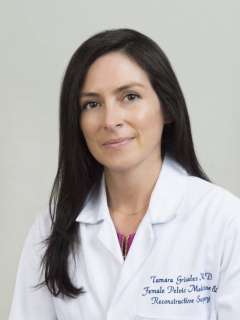UCLA Health has launched a comprehensive OBGYN initiative to treat maternal pelvic floor injury while also researching ways to prevent complications after childbirth and personalize care.
The UCLA Postpartum Pelvic Floor Health Program, which was launched in 2020, offers multidisciplinary care and rehabilitation by urogynecologists, pelvic floor physical therapists and pelvic floor radiologists. Patients range from new mothers to women who gave birth decades ago.
“UCLA is one of the few programs like this in the country,” said Tamara Grisales, MD, assistant clinical professor of obstetrics and gynecology at the David Geffen School of Medicine at UCLA. “Our goal is to provide a resource and a place where a woman can safely discuss and be treated for some of these concerns that arise postpartum, as well as late childbirth consequences.”

The program also aims to serve as a research platform to better understand and treat pelvic floor injury. Doctors hope to better determine which patients are most susceptible to injury and reduce their risk.
“One of the big challenges in our field is to understand how we can prevent these injuries from happening or make them less severe,” said Dr. Grisales, who created the formalized alliance of specialists. “We see women at various times after the injury and they’re having concerns, whether it’s incontinence or prolapse or less commonly pain or sexual function issues. There are consequences of pelvic floor injury that can acutely affect women immediately after delivery and some that may present in a more delayed fashion, perhaps not affecting a woman until decades after delivery.”
The UCLA Postpartum Pelvic Floor Health Program offers diagnostic imaging, counseling and treatment for conditions including third- and fourth-degree tears, pelvic organ prolapse, urinary incontinence, stool leakage, urinary or rectovaginal fistulas and painful intercourse.
“Sometimes that may involve normalizing the situations and setting expectations,” Dr. Grisales said. “Sometimes it can involve very proactive rehabilitation with physical therapy or biofeedback, diagnostic testing or even surgery. We are happy to be a resource for any patient or any OBGYN who feels like a patient needs some additional evaluation or counseling.”
Postpartum pelvic floor health is a growing field that has been driven by patients becoming more empowered to seek information and treatment, Dr. Grisales said.
“A lot of the focus lately is on personalized care and what does each individual woman actually need based on what happened during their pregnancy, during childbirth, and how the birth may be affecting them and whether they had any complications following the delivery,” she said.
Still, patients can report feeling uncomfortable bringing up incontinence or sexual function with their doctors, and providers may not be attuned to inquiring.
“Pelvic floor disorders are concerns that often remain silent,” Dr. Grisales said. “It’s still a very sensitive, intimate topic that is really hard for some women to discuss, and many suffer in silence.”
Even for as long as women have been delivering babies, researchers are still seeking to understand why some women are more likely to suffer injury. That knowledge could help doctors determine who is at higher risk of pelvic floor injury and why, Dr. Grisales said.
Pelvic floor imaging is helping doctors see the pathophysiology of injuries that occur during childbirth.
“There’s a lot of work being done to really understand the true impact of childbirth on these muscles and their coordination and how we can potentially use that information to personalize treatment,” she said.
Dr. Grisales said other avenues for future research may include whether there’s a genetic component to prolapse or if different types of collagen or connective tissue increase risk, and how to predict response to treatment. Another question is whether there could be ways to prepare the pelvic floor or birth canal for the baby’s passage. The UCLA group is also interested in the impact of pelvic floor disorders on mental health postpartum.
UCLA researchers are recruiting patients for a study on stress urinary incontinence that uses ultrasound to see how the levator ani muscles respond to physical therapy. A clinical trial for a device used during labor that is intended to prevent pelvic floor injury is also in the works.
The UCLA Postpartum Pelvic Floor Health Program is also looking at how to improve access to care. In two studies of pelvic floor physical therapy participation rates, UCLA researchers found that urinary incontinence and pelvic pain were the most common reasons for seeking treatment. Researchers noted that patient completion rates were similar regardless of what specialist made the referral. Among the patients referred, 50% attended and 20% completed therapy.
“We’ve started some discussion on determining the barriers to care,” Dr. Grisales said. “Is it that the patients can’t get ahold of someone? Is it the insurance? Is it that they’re too busy? It is our hope that a multidisciplinary approach helps to improve access to and completion of pelvic floor physical therapy.”
The findings were presented at the American Urogynecologic Society Meeting in 2019. The research was conducted by Dr. Christopher Tarnay, associate professor in OBGYN at UCLA, Dr. Grisales, and their research team.
“As an institution, UCLA has a lot of resources,” Dr. Grisales said. “We have top experts in several disciplines that specialize in various aspects of the evaluation and management of pelvic floor conditions. Combined with a passion for elevating women’s health, that really sets us up to do some incredible multidisciplinary research within this group.”
Courtney Perkes is the author of this article.




